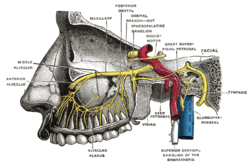Tympanic nerve
| Tympanic nerve | |
|---|---|
 Plan of upper portions of glossopharyngeal, vagus, and accessory nerves. (Tympanic nerve visible in upper right) | |
 Tympanic nerve (labelled right side) | |
| Details | |
| To | tympanic plexus |
| Identifiers | |
| Latin | nervus tympanicus |
| TA98 | A14.2.01.138 |
| TA2 | 6323 |
| FMA | 53480 |
| Anatomical terms of neuroanatomy | |
The tympanic nerve (Jacobson’s nerve) is a branch of the glossopharyngeal nerve found near the ear. It gives sensation to the middle ear, the Eustachian tube, the parotid gland, and mastoid air cells. It gives parasympathetic to supply to the parotid gland via the otic ganglion and the auriculotemporal nerve.
Structure[]
The tympanic nerve arises from the inferior ganglion of the glossopharyngeal nerve.[1] It ascends to the tympanic cavity through a small canal, the inferior tympanic canaliculus, on the under surface of the petrous portion of the temporal bone on the ridge which separates the carotid canal from the jugular fossa.
In the tympanic cavity, it divides into branches which form the tympanic plexus and are contained in grooves upon the surface of the promontory.[1]
The tympanic nerve contains sensory axons to the middle ear, including the internal surface of the tympanic membrane.[1] Their cell bodies are found in the superior ganglion of the glossopharyngeal nerve. It also contains parasympathetic axons, which continue as the lesser petrosal nerve to the otic ganglion, which itself gives off postganglionic parasympathetic neurons.[1]
Variation[]
The tympanic nerve usually arises from the inferior ganglion of the glossopharyngeal nerve.[1] Rarely, it may arise from a higher part.[1] Rarely, it may provide no parasympathetic fibres to the otic ganglion.[2]
Function[]
The tympanic nerve provides sensation to the middle ear (tympanic cavity).[1] This includes the internal surface of the tympanic membrane. It also supplies the Eustachian tube, the parotid gland, and mastoid air cells.[1]
The tympanic nerve also gives parasympathetic supply to the otic ganglion.[1][2] These neurons then provide secretomotor innervation of the parotid gland via the auriculotemporal nerve.[1] It is involved in the salivatory reflex to increase salivation during chewing.[3]
Clinical significance[]
The tympanic nerve is involved in a reflex, where stimulation of the ear canal increases salivation.[3]
Cancer[]
The tympanic nerve may be involved by paraganglioma, in this location referred to as a glomus tympanicum tumour.[4] This causes a soft mass in the middle ear (tympanic cavity).[4] There may also be pulsatile tinnitus, hearing loss or hearing problems, and some cardiac abnormalities.[4]
History[]
The tympanic nerve is also known as the nerve of Jacobson, or Jacobson's nerve.[1]
Additional images[]

Lesser petrosal nerve

Sympathetic connections of the otic and superior cervical ganglia.
References[]
![]() This article incorporates text in the public domain from page 910 of the 20th edition of Gray's Anatomy (1918)
This article incorporates text in the public domain from page 910 of the 20th edition of Gray's Anatomy (1918)
- ^ a b c d e f g h i j k Tubbs, R. Shane; Shoja, Mohammadali; Loukas, Marios (2015). "26 - Anatomy of the Glossopharyngeal Nerve". Nerves and Nerve Injuries. Vol. 1: History, Embryology, Anatomy, Imaging, and Diagnostics. Academic Press. pp. 371–383. doi:10.1016/B978-0-12-410390-0.00027-5. ISBN 978-0-12-410390-0.
- ^ a b Thomas, P. K.; Mathias, Christopher J. (2005). "52 - Diseases of the Ninth, Tenth, Eleventh, and Twelfth Cranial Nerves". Peripheral Neuropathy. Vol. 2 (4th ed.). Saunders. pp. 1273–1293. doi:10.1016/B978-0-7216-9491-7.50055-7. ISBN 978-0-7216-9491-7.
- ^ a b Barral, Jean-Pierre; Croibier, Alain (2009). "21 - Glossopharyngeal nerve". Manual Therapy for the Cranial Nerves. Churchill Livingstone. pp. 181–189. doi:10.1016/B978-0-7020-3100-7.50024-0. ISBN 978-0-7020-3100-7.
- ^ a b c Weissleder, Ralph; Wittenberg, Jack; Harisinghani, Mukesh G.; Chen, John W. (2011). "7 - Head and Neck Imaging". Primer of Diagnostic Imaging (5th ed.). Mosby. pp. 427–461. doi:10.1016/B978-0-323-06538-2.00007-X. ISBN 978-0-323-06538-2.
External links[]
- Tympanic and Lesser petrosal nerve diagram
- cranialnerves at The Anatomy Lesson by Wesley Norman (Georgetown University) (IX)
- Wikipedia articles incorporating text from the 20th edition of Gray's Anatomy (1918)
- Glossopharyngeal nerve

